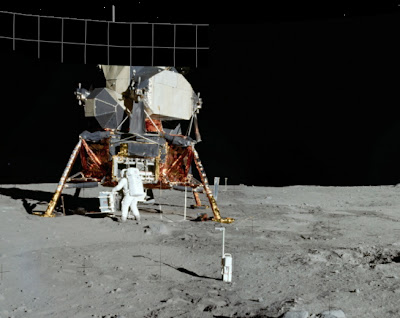Users can explore a virtual Moonscape, follow guided tours from Apollo 11 astronaut Buzz Aldrin and Apollo 17‘s Jack Schmitt, see the latest rover concepts by teams competing in the Google Lunar X-Prize, view high-resolution panoramic photos, watch previously unreleased video footage captured from the lunar surface, and much more.Moon in Google Earth also incorporates a complete lunar terrain data-set by Kaguya LALT, produced by JAXA/NAOJ, which serves as the atlas’ base-map.
It’s all very slick and great fun to use, although we’re disappointed Google hasn’t slipped in a few aliens for the SF fans. Perhaps next April 1st…
“40 years ago, two human beings walked on the Moon. Starting today, with Moon in Google Earth, it’s now possible for anyone to follow in their footsteps,” said Moon in Google Earth Product Manager, Michael Weiss-Malik. “We’re giving hundreds of millions of people around the world unprecedented access to an interactive 3D presentation of the Apollo missions.”
The most recent tool to have been developed as a result of the Space Act Agreement between Google and NASA, Moon in Google Earth enables information about the Moon to be accessible to anyone in a unique three-dimensional context.
In addition to satellite imagery and terrain, the following layers can be explored with Moon in Google Earth:
• Featured Satellite Imagery – Explore overlaid satellite imagery and detailed descriptions of selected areas on the Moon from Arizona State University’s ‘Lunar Image of the Week’
• Spacecraft Imagery – View selected imagery captured by the Apollo Metric Camera, Clementine, and the Lunar Orbiter
• Apollo Missions – Travel back to the Apollo era and discover the landing sites of Apollo missions 11-17. Explore “Street View”–style panoramic images, watch previously unreleased footage from Spacecraft films, and read about the places astronauts saw on their trips to the Moon.
• Guided Tours – Take a narrated tour of the Moon from Apollo astronauts Buzz Aldrin (Apollo 11) and Jack Schmitt (Apollo 17)
• Historic Maps – Discover Apollo-era geologic and topographic maps of the Moon that were used in mission control for trips to the Moon
• Human Artifacts – Learn about the various types of exploratory equipment that humans have left on the Moon and where those objects can be found today. Artifacts from the United States, the Soviet Union, China, the EU, Japan, and India are included, some of them as 3D models.
• To experience Moon in Google Earth, open Google Earth 5.0 and switch modes from ‘Earth’ to ‘Moon’ on the top toolbar. Google Earth 5.0 can be downloaded at http://earth.google.com/moon.









